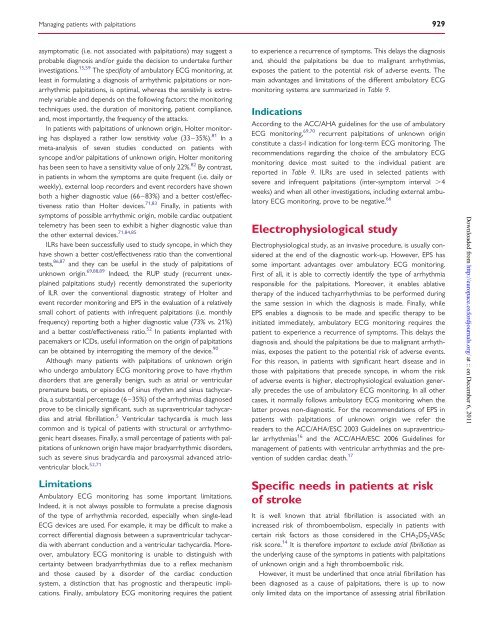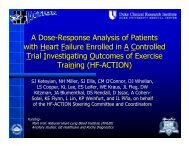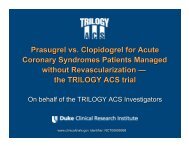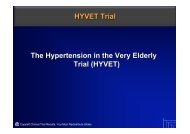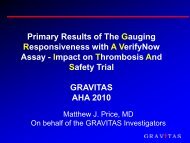Management of patients with palpitations: a position paper from the ...
Management of patients with palpitations: a position paper from the ...
Management of patients with palpitations: a position paper from the ...
Create successful ePaper yourself
Turn your PDF publications into a flip-book with our unique Google optimized e-Paper software.
Managing <strong>patients</strong> <strong>with</strong> <strong>palpitations</strong> 929asymptomatic (i.e. not associated <strong>with</strong> <strong>palpitations</strong>) may suggest aprobable diagnosis and/or guide <strong>the</strong> decision to undertake fur<strong>the</strong>rinvestigations. 15,59 The specificity <strong>of</strong> ambulatory ECG monitoring, atleast in formulating a diagnosis <strong>of</strong> arrhythmic <strong>palpitations</strong> or nonarrhythmic<strong>palpitations</strong>, is optimal, whereas <strong>the</strong> sensitivity is extremelyvariable and depends on <strong>the</strong> following factors: <strong>the</strong> monitoringtechniques used, <strong>the</strong> duration <strong>of</strong> monitoring, patient compliance,and, most importantly, <strong>the</strong> frequency <strong>of</strong> <strong>the</strong> attacks.In <strong>patients</strong> <strong>with</strong> <strong>palpitations</strong> <strong>of</strong> unknown origin, Holter monitoringhas displayed a ra<strong>the</strong>r low sensitivity value (33–35%). 81 In ameta-analysis <strong>of</strong> seven studies conducted on <strong>patients</strong> <strong>with</strong>syncope and/or <strong>palpitations</strong> <strong>of</strong> unknown origin, Holter monitoringhas been seen to have a sensitivity value <strong>of</strong> only 22%. 82 By contrast,in <strong>patients</strong> in whom <strong>the</strong> symptoms are quite frequent (i.e. daily orweekly), external loop recorders and event recorders have shownboth a higher diagnostic value (66–83%) and a better cost/effectivenessratio than Holter devices. 71,83 Finally, in <strong>patients</strong> <strong>with</strong>symptoms <strong>of</strong> possible arrhythmic origin, mobile cardiac outpatienttelemetry has been seen to exhibit a higher diagnostic value than<strong>the</strong> o<strong>the</strong>r external devices. 71,84,85ILRs have been successfully used to study syncope, in which <strong>the</strong>yhave shown a better cost/effectiveness ratio than <strong>the</strong> conventionaltests, 86,87 and <strong>the</strong>y can be useful in <strong>the</strong> study <strong>of</strong> <strong>palpitations</strong> <strong>of</strong>unknown origin. 69,88,89 Indeed, <strong>the</strong> RUP study (recurrent unexplained<strong>palpitations</strong> study) recently demonstrated <strong>the</strong> superiority<strong>of</strong> ILR over <strong>the</strong> conventional diagnostic strategy <strong>of</strong> Holter andevent recorder monitoring and EPS in <strong>the</strong> evaluation <strong>of</strong> a relativelysmall cohort <strong>of</strong> <strong>patients</strong> <strong>with</strong> infrequent <strong>palpitations</strong> (i.e. monthlyfrequency) reporting both a higher diagnostic value (73% vs. 21%)and a better cost/effectiveness ratio. 52 In <strong>patients</strong> implanted <strong>with</strong>pacemakers or ICDs, useful information on <strong>the</strong> origin <strong>of</strong> <strong>palpitations</strong>can be obtained by interrogating <strong>the</strong> memory <strong>of</strong> <strong>the</strong> device. 90Although many <strong>patients</strong> <strong>with</strong> <strong>palpitations</strong> <strong>of</strong> unknown originwho undergo ambulatory ECG monitoring prove to have rhythmdisorders that are generally benign, such as atrial or ventricularpremature beats, or episodes <strong>of</strong> sinus rhythm and sinus tachycardia,a substantial percentage (6–35%) <strong>of</strong> <strong>the</strong> arrhythmias diagnosedprove to be clinically significant, such as supraventricular tachycardiasand atrial fibrillation. 5 Ventricular tachycardia is much lesscommon and is typical <strong>of</strong> <strong>patients</strong> <strong>with</strong> structural or arrhythmogenicheart diseases. Finally, a small percentage <strong>of</strong> <strong>patients</strong> <strong>with</strong> <strong>palpitations</strong><strong>of</strong> unknown origin have major bradyarrhythmic disorders,such as severe sinus bradycardia and paroxysmal advanced atrioventricularblock. 52,71LimitationsAmbulatory ECG monitoring has some important limitations.Indeed, it is not always possible to formulate a precise diagnosis<strong>of</strong> <strong>the</strong> type <strong>of</strong> arrhythmia recorded, especially when single-leadECG devices are used. For example, it may be difficult to make acorrect differential diagnosis between a supraventricular tachycardia<strong>with</strong> aberrant conduction and a ventricular tachycardia. Moreover,ambulatory ECG monitoring is unable to distinguish <strong>with</strong>certainty between bradyarrhythmias due to a reflex mechanismand those caused by a disorder <strong>of</strong> <strong>the</strong> cardiac conductionsystem, a distinction that has prognostic and <strong>the</strong>rapeutic implications.Finally, ambulatory ECG monitoring requires <strong>the</strong> patientto experience a recurrence <strong>of</strong> symptoms. This delays <strong>the</strong> diagnosisand, should <strong>the</strong> <strong>palpitations</strong> be due to malignant arrhythmias,exposes <strong>the</strong> patient to <strong>the</strong> potential risk <strong>of</strong> adverse events. Themain advantages and limitations <strong>of</strong> <strong>the</strong> different ambulatory ECGmonitoring systems are summarized in Table 9.IndicationsAccording to <strong>the</strong> ACC/AHA guidelines for <strong>the</strong> use <strong>of</strong> ambulatoryECG monitoring, 69,70 recurrent <strong>palpitations</strong> <strong>of</strong> unknown originconstitute a class-I indication for long-term ECG monitoring. Therecommendations regarding <strong>the</strong> choice <strong>of</strong> <strong>the</strong> ambulatory ECGmonitoring device most suited to <strong>the</strong> individual patient arereported in Table 9. ILRs are used in selected <strong>patients</strong> <strong>with</strong>severe and infrequent <strong>palpitations</strong> (inter-symptom interval .4weeks) and when all o<strong>the</strong>r investigations, including external ambulatoryECG monitoring, prove to be negative. 66Electrophysiological studyElectrophysiological study, as an invasive procedure, is usually consideredat <strong>the</strong> end <strong>of</strong> <strong>the</strong> diagnostic work-up. However, EPS hassome important advantages over ambulatory ECG monitoring.First <strong>of</strong> all, it is able to correctly identify <strong>the</strong> type <strong>of</strong> arrhythmiaresponsible for <strong>the</strong> <strong>palpitations</strong>. Moreover, it enables ablative<strong>the</strong>rapy <strong>of</strong> <strong>the</strong> induced tachyarrhythmias to be performed during<strong>the</strong> same session in which <strong>the</strong> diagnosis is made. Finally, whileEPS enables a diagnosis to be made and specific <strong>the</strong>rapy to beinitiated immediately, ambulatory ECG monitoring requires <strong>the</strong>patient to experience a recurrence <strong>of</strong> symptoms. This delays <strong>the</strong>diagnosis and, should <strong>the</strong> <strong>palpitations</strong> be due to malignant arrhythmias,exposes <strong>the</strong> patient to <strong>the</strong> potential risk <strong>of</strong> adverse events.For this reason, in <strong>patients</strong> <strong>with</strong> significant heart disease and inthose <strong>with</strong> <strong>palpitations</strong> that precede syncope, in whom <strong>the</strong> risk<strong>of</strong> adverse events is higher, electrophysiological evaluation generallyprecedes <strong>the</strong> use <strong>of</strong> ambulatory ECG monitoring. In all o<strong>the</strong>rcases, it normally follows ambulatory ECG monitoring when <strong>the</strong>latter proves non-diagnostic. For <strong>the</strong> recommendations <strong>of</strong> EPS in<strong>patients</strong> <strong>with</strong> <strong>palpitations</strong> <strong>of</strong> unknown origin we refer <strong>the</strong>readers to <strong>the</strong> ACC/AHA/ESC 2003 Guidelines on supraventriculararrhythmias 16 and <strong>the</strong> ACC/AHA/ESC 2006 Guidelines formanagement <strong>of</strong> <strong>patients</strong> <strong>with</strong> ventricular arrhythmias and <strong>the</strong> prevention<strong>of</strong> sudden cardiac death. 17Specific needs in <strong>patients</strong> at risk<strong>of</strong> strokeIt is well known that atrial fibrillation is associated <strong>with</strong> anincreased risk <strong>of</strong> thromboembolism, especially in <strong>patients</strong> <strong>with</strong>certain risk factors as those considered in <strong>the</strong> CHA 2 DS 2 VAScrisk score. 14 It is <strong>the</strong>refore important to exclude atrial fibrillation as<strong>the</strong> underlying cause <strong>of</strong> <strong>the</strong> symptoms in <strong>patients</strong> <strong>with</strong> <strong>palpitations</strong><strong>of</strong> unknown origin and a high thromboembolic risk.However, it must be underlined that once atrial fibrillation hasbeen diagnosed as a cause <strong>of</strong> <strong>palpitations</strong>, <strong>the</strong>re is up to nowonly limited data on <strong>the</strong> importance <strong>of</strong> assessing atrial fibrillationDownloaded <strong>from</strong> http://europace.oxfordjournals.org/ at :: on December 6, 2011


